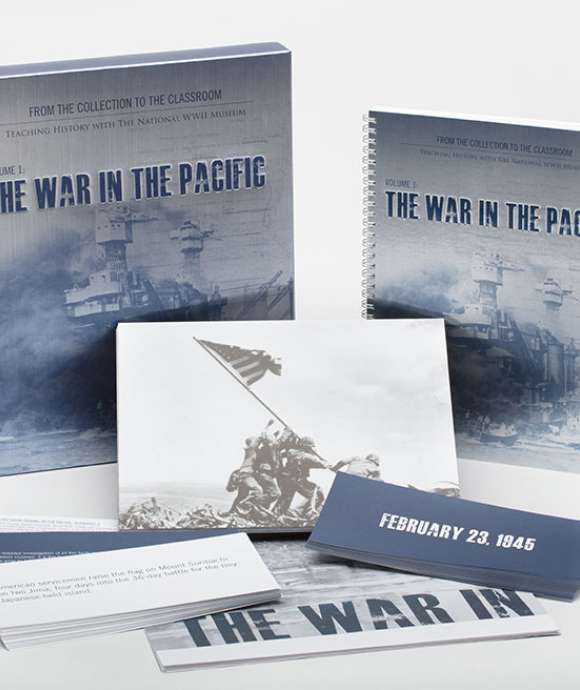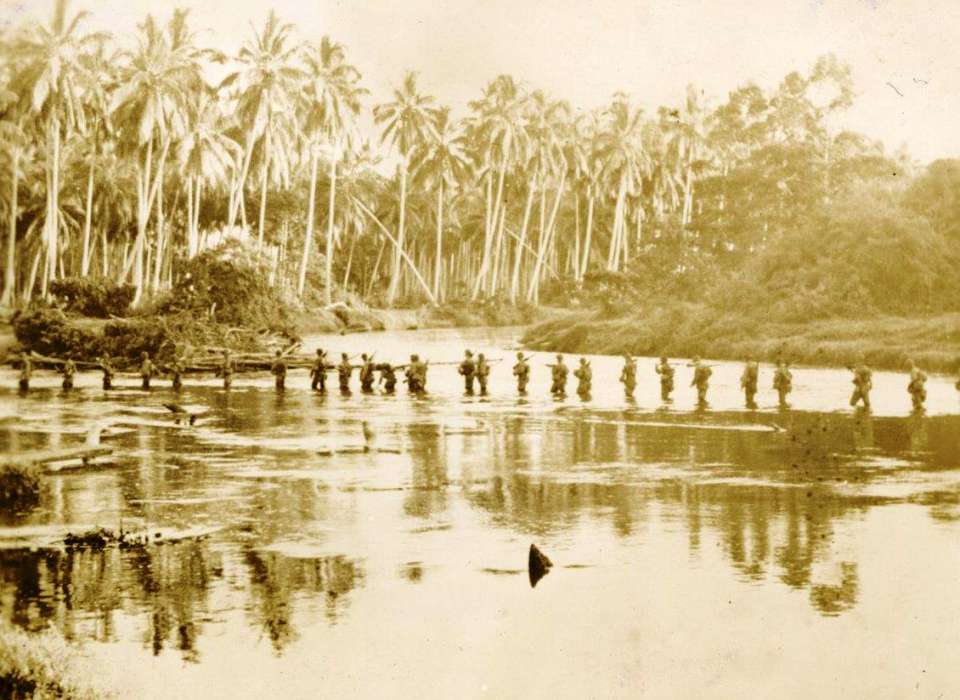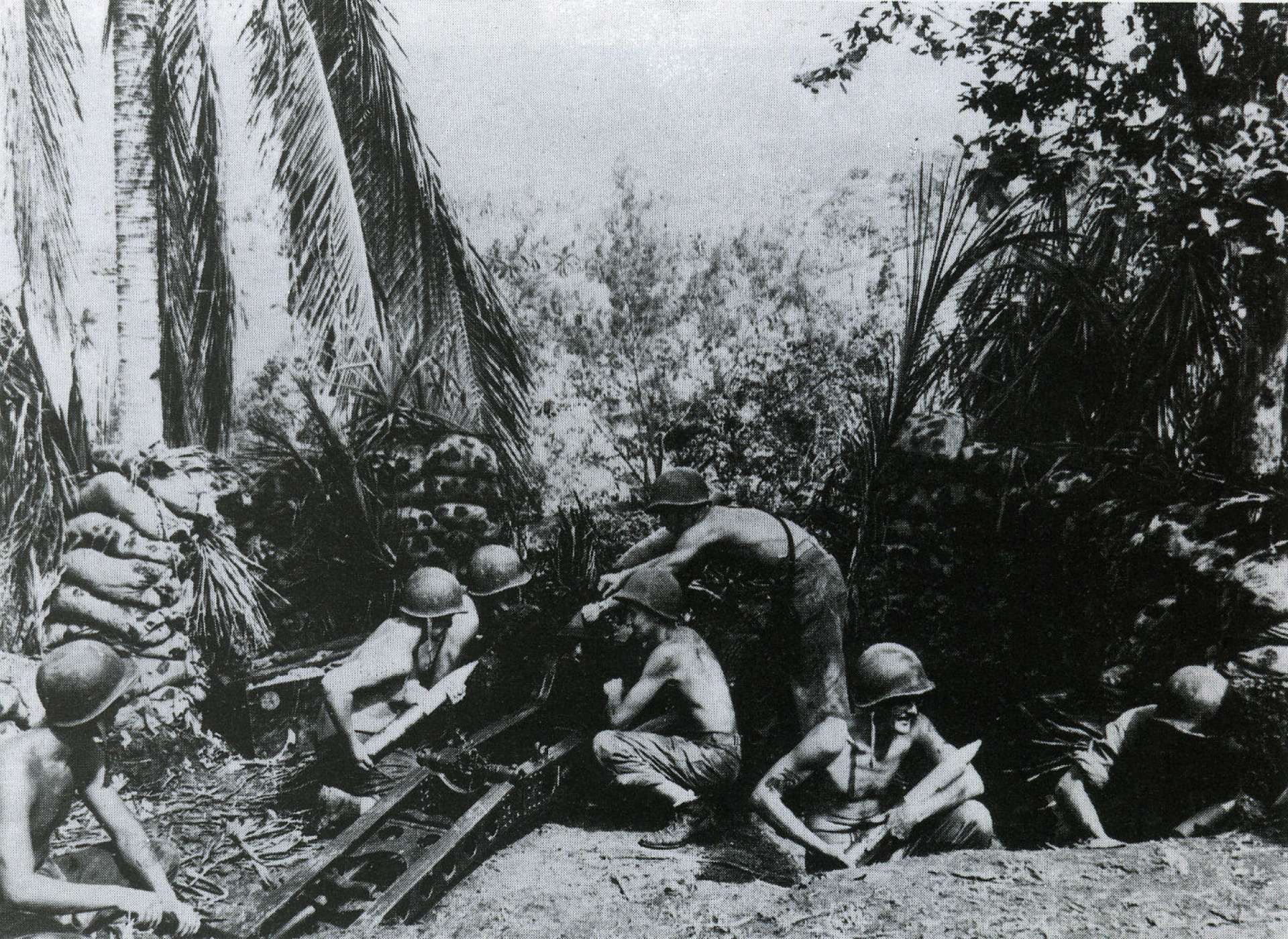Primary Image: On Guadalcanal, American servicemembers battled heat, mosquitoes, disease, dense vegetation, and unfamiliar terrain along with a determined Japanese enemy in an all-consuming, round-the-clock battle. (Image: The National WWII Museum, 2002.069.144.)
Following its attack on Pearl Harbor (December 7, 1941), the Japanese Imperial Navy occupied islands throughout the western Pacific Ocean. Japan’s goal was to create a defensive buffer against attack from the United States and its allies—one that would ensure Japan mastery over east Asia and the southwest Pacific. After the US strategic victories at the Battles of the Coral Sea (May 7–8, 1942) and Midway (June 4–7, 1942), the Japanese Imperial Navy was no longer capable of major offensive campaigns, which permitted the Allies to start their own offensive in the Pacific.
In August 1942, America mounted its first major amphibious landing of World War II at Guadalcanal, using innovative landing craft built by Higgins Industries in New Orleans. By seizing a strategic airfield site on the island, the United States halted Japanese efforts to disrupt supply routes to Australia and New Zealand. The invasion ignited a ferocious struggle marked by
seven major naval battles, numerous clashes ashore, and almost continuous air combat. For six long months US forces fought to hold the island. In the end they prevailed, and the Allies took the first vital step in driving the Japanese back in the Pacific theater.
The Battles
American forces first landed on the Solomon Islands of Guadalcanal, Tulagi, and Florida on the morning of August 7,1942. After some fierce fighting, the US Marines cleared Tulagi and Florida by August 9. The main forces on Guadalcanal met little resistance on their way inland to secure the airfield at Lunga Point, which was soon renamed Henderson Field after Loy Henderson, an aviator killed at the Battle of Midway. Almost immediately, however, Japanese naval aircraft attacked transport and escort ships, and Japanese reinforcements arrived in the area.
Over the following days, the first of many deadly naval battles occurred—the Naval Battle of Savo Island. The fight for control of Guadalcanal, its critical airfield, and the seas around them continued for months with both sides losing men, ships, and aircraft and with neither side able to drive the other off the island.
During the first amphibious invasion in the Pacific, the United States made many initial mistakes, including not having the proper resources on the beaches to move men and matériel inland. The logistical challenges of transport and supply across the Pacific were also immense. Difficult jungle terrain, inhospitable weather, lack of infrastructure, and a foe that fought to the death gave the United States its first taste of what was to come throughout the Pacific war. It seemed that every time the United States inched closer to victory, the Japanese would resupply Guadalcanal by night and be ready for more fighting the next day.
-

On Guadalcanal, American servicemembers battled heat, mosquitoes, disease, dense vegetation, and unfamiliar terrain along with a determined Japanese enemy in an all-consuming, round-the-clock battle. (Image: The National WWII Museum, 2002.069.144.)
-

Members of the U.S. 11th Marines with a 75mm pack howitzer on Guadalcanal, 1942. (Image: National Archives and Records Administration.)
Determined to achieve a decisive victory, Japanese forces massed for an all-out attack in October 1942. Meanwhile, the Marines finally began receiving fresh reinforcements, including soldiers from the US Army. The Americans strengthened their defenses at Henderson Field and launched aggressive jabs to keep the Japanese off-balance. When the Japanese Seventeenth Army launched the assault on October 23, 1942, striking at multiple points along the airfield perimeter over four days, tenacious fighting by US Marines and soldiers threw back the attacks. American losses were significant, but Japanese losses were devastating.
The battle at sea also heated up in the fall of 1942. On October 26, American and Japanese naval forces clashed off the Santa Cruz Islands. Japan secured a tactical victory, sinking the carrier Hornet, but paid a severe price in aircraft and skilled aircrew. Then from November 12–15, in the frantic Naval Battle of Guadalcanal, American sailors and airmen blocked Japan’s last effort to knock out Henderson Field from the sea, at heavy cost. As one Japanese officer noted, “This was the fork in the road.” While fighting continued on the island, the Japanese withdrew their final men and left the island to the Allies in February 1943.

Like this article? Read more in our online classroom.
From the Collection to the Classroom: Teaching History with The National WWII Museum
The Outcome
The Solomon Islands Campaign cost the Allies approximately 7,100 men, 29 ships, and 615 aircraft. The Japanese lost 31,000 men, 38 ships, and 683 aircraft. Over the next two and a half years, US forces captured the Gilbert Islands (Tarawa and Makin), the Marshall Islands (Kwajalein and Eniwetok), the Mariana Islands (Saipan, Guam, and Tinian), Iwo Jima, and Okinawa. With each island taken from the Japanese, the United States moved closer to Japan. Growing superiority at sea and in the air, as well as in the number of fighting men, gave the United States increasing advantages. Nonetheless, wherever US forces met Japanese defenders, the enemy fought long and hard before being defeated.
Cite this article:
MLA Citation:
APA Citation:
Chicago Style Citation:










